Windows Phone 7 Series Thoughts

Waiting for Launch, Picking my Phone
When I first saw the announcements about the latest generation of Windows phones, I was skeptical about how useful the differences would be. The concepts of hubs and live tiles are pretty different from what everyone else (Google, Apple, Palm) is doing: Android has gadgets which are similar to Live tiles, some apps for the various phones have UI that is similar to the hub concept, but no phones are really as strongly oriented to a consistent experience and to having a gadget-like feature for every app. To me, it seemed like this different approach to phones and the phone experience would definitely be hit or miss. I also was pretty skeptical about how having all these live tiles would affect the performance of the phone.
At launch, I decided that I wanted to get the Dell Venue Pro, but unfortunately, this mysterious phone has since been in short supply. Excited about it, I went by the Microsoft store regularly to see if they had any new information about it or whether they had it in stock. To date, Dell hasn’t shipped the phone and there has been zero distribution of the device. For me, it was really disappointing to have the most anticipated phone not be available but I have gotten over it. I decided that there are plenty of good phones available and I was out of contract with T-Mobile so I left them for the first company I could find that had a decent looking keyboard slider. I ultimately decided on the LG Quantum, AT&T’s keyboard slider.
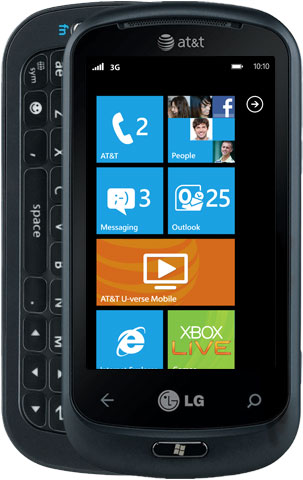
First Impressions, default Tiles
The phone has a large keyboard with plenty of spacing between keys. The screen is very responsive but is nowhere near as big as the HD2 or HD7 screen. The phone came preloaded with tons of AT&T’s bundle apps, none which I was too excited about, and then to my surprise, I was able to remove all of them! I set up my email and all my contacts were pulled down into my phone from the cloud. I set up my marketplace account and then downloaded some apps. The whole experience was really smooth and the phone remained very responsive over the course of the process.
The phone includes a couple baseline tiles but the people, pictures, and music tiles seemed to be the most prominent to me. The people tile integrates Facebook data with contact data pivoting across the hub lets you glance at things like recent calls and so forth. The pictures tile integrates the latest pictures that you have taken with your phone’s camera with photos from Facebook and Zune which can be pivoted by sliding across the hub. The Music tile is a link that launches the Zune experience on the phone and updates with album art from the last couple songs you listened to. All in all, these tiles are rock solid. Performance is great, the hubs make sense, and everything integrates veand ry cleanly and has great aesthetics.
Marketplace
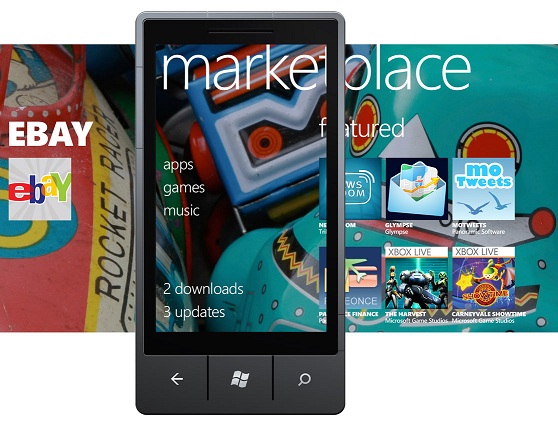
After getting my phone going, I started playing with more of the apps. I installed the Facebook, Shazam, Twitter, and Foursquare apps and was amazed when I realized the similarities and differences between these apps and their Droid/iPhone equivalents. The twitter app is just butter: performing updates is easy, attaching pictures is seamless, navigating across the hub flips you between your feed, mentions, and DMs. The Foursquare app took some getting used to but works as expected. The Facebook app is the best Facebook app I have seen: all the information loads quickly and it’s easy to share things with friends. Fonts and UI is very consistent across applications; developers really seem to know how to create apps that take advantage of the phone’s capabilities and it’s showing already.
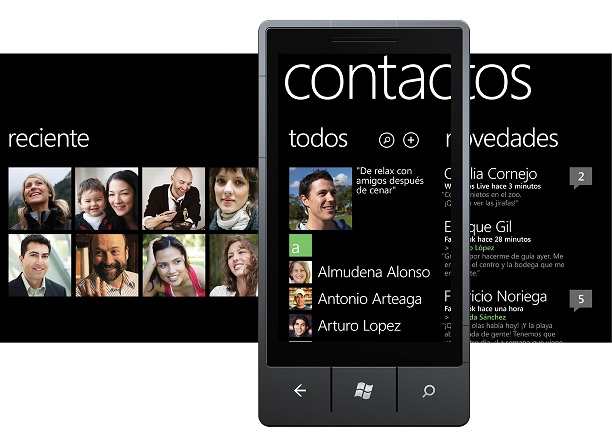
After getting through the basics, I started looking more closely at the app stores: my phone integrates two third party app stores from LG and AT&T. Very surprisingly, I like these extra stores! The LG store gives you exclusive apps that were developed by LG such as a fancy Workout tracker and a “Toolbox” app that includes a light, unit convertor, level, and so on. Through the AT&T store, I got free games! I never expected the 3rd party stores to really offer much, so getting useful and free apps through these stores was a pleasant surprise.
Games
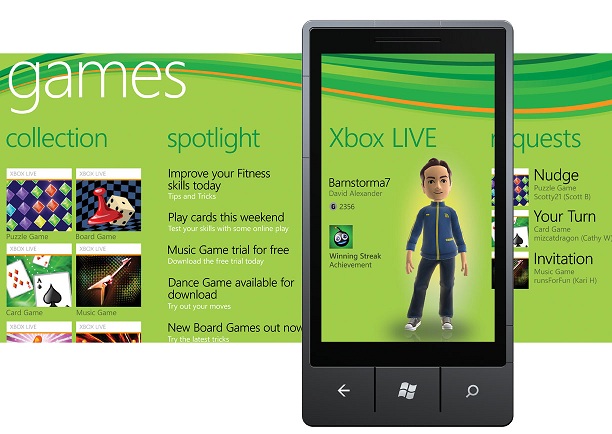
I like to think of the Windows Phone 7 Series as THE Xbox phone platform. At launch, Microsoft offers the Xbox experience through the games tile. Launching the games tile brings up your Xbox live avatar and lets you get to all the games and marketplace features for games. I downloaded a few games and was disappointed after downloading them when I realized that I had to sync with Zune in order to get them to work. After much fudgery and redownloading, I got the games installed on my phone.
The games experience on the Windows Phone is the best games experience I have ever seen on any portable device, ever. I own a PSP, a DS, and have owned the iPhone and Android phones and none of them offer anywhere near as engaging a games launch experience as the Windows Phone (once you get around the Zune / download issues). The games have achievements and live integration which means that you are incented to try and explore the games you purchase and get cool stuff like live leaderboards.
The games themselves are the best versions of the games I have played on ANY platform for the ones that I played. I’m thinking specifically about Bejeweled when I say this, the live leaderboards, achievements, and smooth graphics differentiate the game enough from its Android and iPhone equivalent to make it a smart purchase even if you own the other variants. Puzzle Quest 2 is the kind of game I could play in marathon sessions while traveling. Need for Speed Undercover has great graphics that showcase the capabilities of the hardware. Ilomilo was free for download from the AT&T store and is extremely cute and fun. The harvest plays like a AAA title on a home gaming system. In other words, for gamers, this could very well become the phone to have: games look great, Xbox live is awesome, and there is already a pretty vibrant selection of great titles.
Other nice Touches
The camera experience on this phone is the best that I have seen: from the time the phone is off until the time I am taking pictures is no longer than a point and shoot is and I don’t have to fudge around with lock screens. By pressing and holding the dedicated camera shutter button on the device, you will launch the camera experience regardless of the phone’s state. After you take pictures, they can automatically be synced to the cloud; my pictures get uploaded to my SkyDrive as I take them. Sharing pictures hooks into all the tiles that you have installed or configured. For example, I can send my pictures to Facebook, Twitter, and my various email accounts without any configuration on my end from the pictures app.
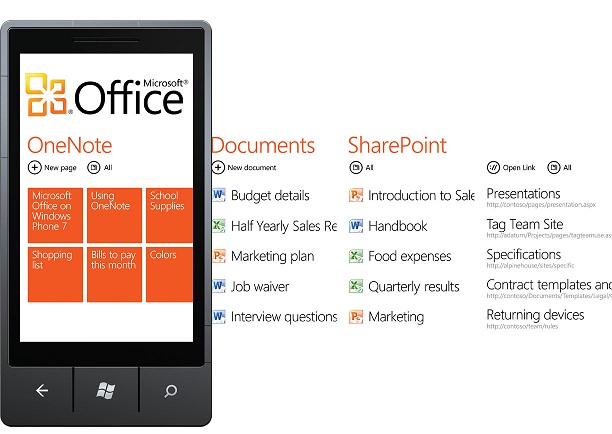
Having Office in your pocket is really nice. The last phone I owned was Windows Mobile 6.5 so I was somewhat spoiled because I could open Office attachments while riding the bus or if I was at a meeting without my laptop. Office support from Windows Phones is sufficient to make edits in Office documents which is pretty impressive considering the small footprint Office has on the phone.
The whole experience really clearly brings together the Microsoft ecosystem and makes the device feel tightly connected to the cloud. Every app seems connected to other apps: the photo sharing experience is a great example. It’s very refreshing to see Bing, IE, Zune, Office, Xbox, and Windows Mobile all shipping together in a single experience. Outside of Windows, the Windows phone seems to be the most integrated Microsoft product I have seen.
The phone is very customizable and the experience for setting up the phone is clean. The animated home screen tiles, which are totally under the user’s control, really make the phone “yours” and this is evidenced in your ability to clean all the carrier cruft from your phone if you choose to do so. Additionally, the things that you want to change in the UI: home screen tile colors, lock screen background, and so on are easily discovered in the settings menu. All the things that detractors threw at me, “but can it do…” were easily addressed by me even when I didn’t know the phone could do it.
Caveats
There are a few things that I missed a little bit in the phone that other phones have covered: copy and paste, custom ringtones, and animated backgrounds. Microsoft deliberately cut these features to ensure that the rest of the core functionality was solid. I miss these features a little bit, but the rest of the package being so slick makes it easy for me to have no reservations about waiting for v-next nailing them down. I rarely use copy and paste on my phone but once or twice I have needed it since the switch to WinPho. I almost never use a ringer, but I feel a little disappointed that I don’t have the freedom to customize mine. The lack of animated backgrounds (live wallpapers) was the main reason I was disappointed with the iPhone 4 but after some experience with how they affect battery life on Android I’m not sure I will miss them on my new phone. Also, battery life wasn’t as good as I would have liked: I found myself needing to charge the phone daily. I’m not sure if the battery life was hit because of the live tiles I set up or because I was pretty intensively playing with the phone, but I’m probably going to end up buying an extra or extended life battery before long.
Conclusions
I think the Windows Phone 7 Series phone (phone) launch really brought Microsoft back into the game. The UI is different but useful. The games are plentiful, fun, and the gaming experience pwns. The phone’s fundamentals are rock solid. The most important apps on other platforms have equivalents in our marketplace. I’m not a fan of the phone’s title, the missing features are noticeable, but I’m optimistic about where things are going for this device / ecosystem. The cloud and Microsoft’s comprehensive product integration shows through the entire device experience. I can’t wait to see how things turn out with future iterations of the product and with the apps that partners create.